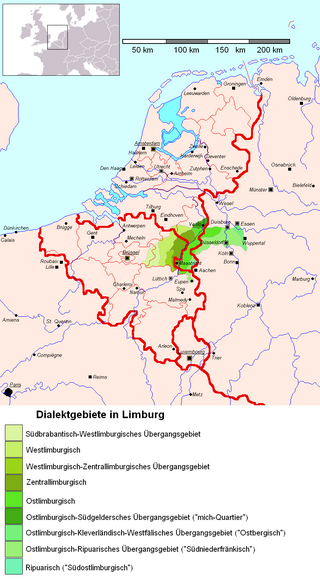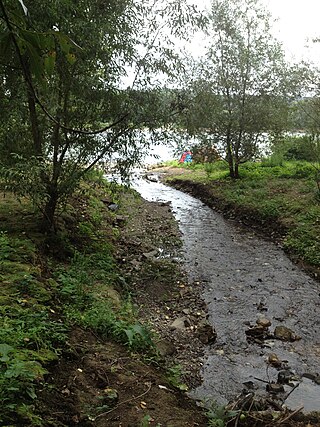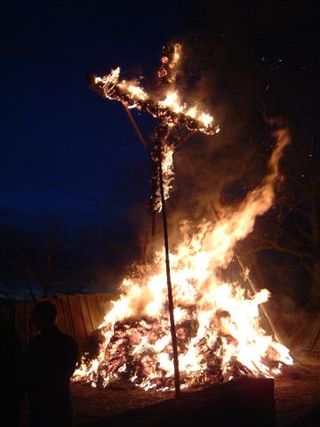The High German languages, or simply High German – not to be confused with Standard High German which is commonly also called "High German" – comprise the varieties of German spoken south of the Benrath and Uerdingen isoglosses in central and southern Germany, Austria, Liechtenstein, Switzerland, Luxembourg, and eastern Belgium, as well as in neighbouring portions of France, Italy, the Czech Republic (Bohemia), and Poland. They are also spoken in diasporas in Romania, Russia, Canada, the United States, Brazil, Argentina, Mexico, Chile, and Namibia.

In historical and comparative linguistics, Low Franconian is a linguistic category used to classify a number of historical and contemporary West Germanic varieties closely related to, and including, the Dutch language. Most dialects and languages included within this category are spoken in the Netherlands, northern Belgium (Flanders), in the Nord department of France, in western Germany, as well as in Suriname, South Africa and Namibia.

The Eifel is a low mountain range in western Germany, eastern Belgium and northern Luxembourg. It occupies parts of southwestern North Rhine-Westphalia, northwestern Rhineland-Palatinate and the southern area of the German-speaking Community of Belgium.
Colognian or Kölsch is a small set of very closely related dialects, or variants, of the Ripuarian group of dialects of the Central German group. These dialects are spoken in the area covered by the Archdiocese and former Electorate of Cologne reaching from Neuss in the north to just south of Bonn, west to Düren and east to Olpe in northwest Germany.

Ripuarian or Ripuarian Franconian is a German dialect group, part of the West Central German language group. Together with the Moselle Franconian which includes the Luxembourgish language, Ripuarian belongs to the larger Central Franconian dialect family and also to the linguistic continuum with the Low Franconian languages.

Andernach is a town in the district of Mayen-Koblenz, in Rhineland-Palatinate, Germany, of about 30,000 inhabitants. It is situated towards the end of the Neuwied basin on the left bank of the Rhine between the former tiny fishing village of Fornich in the north and the mouth of the small river Nette in the southeast, just 13 miles (21 km) north of Koblenz, with its five external town districts: Kell, Miesenheim, Eich, Namedy, and Bad Tönisstein.

South Franconian or South Rhine Franconian is an Upper German dialect which is spoken in the northernmost part of Baden-Württemberg in Germany, around Karlsruhe, Mosbach and Heilbronn. Like closely related East Franconian it is a transitional dialect, which unites elements of Central German and Upper German.

Lorraine Franconian is an ambiguous designation for dialects of West Central German, a group of High German dialects spoken in the Moselle department of the former northeastern French region of Lorraine.

Rhinelandic is a term occasionally used for linguistic varieties of a region on both sides of the Middle and Lower Rhine river in Central West Germany, Belgium, the Netherlands, and Luxembourg, including some varieties of the Limburgish language group, Kleverlandish, Moselle Franconian and Ripuarian. The Local languages of villages or cities are commonly referred to as "the dialects" or "dialect". One of the meanings of Rhinelandic is that of a group of local languages in an area called the Rhineland. Another meaning is that of the regiolect being used by the people approximately of the same area.

Rhenish Franconian or Rhine Franconian is a dialect chain of West Central German. It comprises the varieties of German spoken across the western regions of the states of Saarland, Rhineland-Palatinate, northwest Baden-Württemberg, and Hesse in Germany. It is also spoken in northeast France, in the eastern part of the département of Moselle in the Lorraine region, and in the north-west part of Bas-Rhin in Alsace. To the north, it is bounded by the Sankt Goar line which separates it from Moselle Franconian; to the south, it is bounded by the Main line which is also referred to as the Speyer line which separates it from the Upper German dialects.

Binningen is an Ortsgemeinde – a municipality belonging to a Verbandsgemeinde, a kind of collective municipality – in the Cochem-Zell district in Rhineland-Palatinate, Germany. It belongs to the Verbandsgemeinde of Kaisersesch.

Weidenbach is an Ortsgemeinde – a municipality belonging to a Verbandsgemeinde, a kind of collective municipality – in the Vulkaneifel district in Rhineland-Palatinate, Germany. It belongs to the Verbandsgemeinde of Daun, whose seat is in the like-named town. In Weidenbach, a Moselle Franconian dialect is spoken.

Bergish is a collective name for a group of West Germanic dialects spoken in the Bergisches Land region east of the Rhine in western Germany.
The Eifel rule is a phonological phenomenon consisting in the deletion of morpheme-final in certain contexts, originally documented in the dialects of the Eifel region in the far west of Germany during the late 19th century. This is a sandhi phenomenon and may or may not be reflected in spelling, depending on the language concerned.

Euskirchen station is an important transport hub with heavy commuter traffic in the German state of North Rhine-Westphalia. It is it situated on Cologne–Trier, Bonn–Euskirchen, Euskirchen–Bad Münstereifel and the Euskirchen–Düren lines. The station is located on Alleestraße (street) on the Pützberg (hill) and is the largest station in the district.
The Caerosi were a small Belgic-Germanic tribe that lived in Gallia Belgica during the Iron Age and the Roman period. Their ethnic identity remains uncertain. Caesar described them as part of the Germani Cisrhenani, but their tribal name is probably of Celtic origin. Like other Germani Cisrhenani tribes, it is possible that their old Germanic endonym came to be abandoned after a tribal reorganization, that they received their names from their Celtic neighbours, or else that they were fully or partially assimilated into Celtic culture at the time of the Roman invasion of the region in 57 BC.

The Vinxtbach is a stream of Rhineland-Palatinate, Germany. It is around 19 km (12 mi) long, rises south-southwest of Schalkenbach-Obervinxt and east of the Adert and discharges into the River Rhine near Rheineck Castle between Bad Breisig and Brohl-Lützing.

Hüttenbrennen, sometimes also referred to as Burgbrennen, is an old-fashioned bonfire custom in many part of the Eifel mountains in Germany. It is celebrated every year on "Straw Sunday", the first Sunday after Shrove Tuesday, also observed as Funkensonntag.
Siegerländisch is the northeasternmost dialect of the Moselle Franconian Dialect Group. Siegerländisch is spoken in the region around the city of Siegen in Germany. The dialect is also spoken in parts of northern Altenkirchen as well as parts of the Westerwaldkreis. It has strong lexical similarities to the Hessian dialects and to South Westphalian, which are spoken in surrounding regions. It belongs to the West Central German branch of the High German languages. It is bounded on the north by the Benrath line, which separates it from the Westphalian language and thus from Low German, as well as on the east by the Sankt Goar line and on the west by the Eifel and the Ripuarian language.

Trierisch is a dialect group spoken in the city of Trier. Colloquially, it is known as "Trier Platt". Trierisch belongs to the Moselle Franconian dialect group. There is not just one Trierisch dialect, but different ones depending on the district of Trier. Trierisch also differs quite significantly from the dialects of the surrounding villages, whose residents do not usually refer to their dialect as Trierisch.














